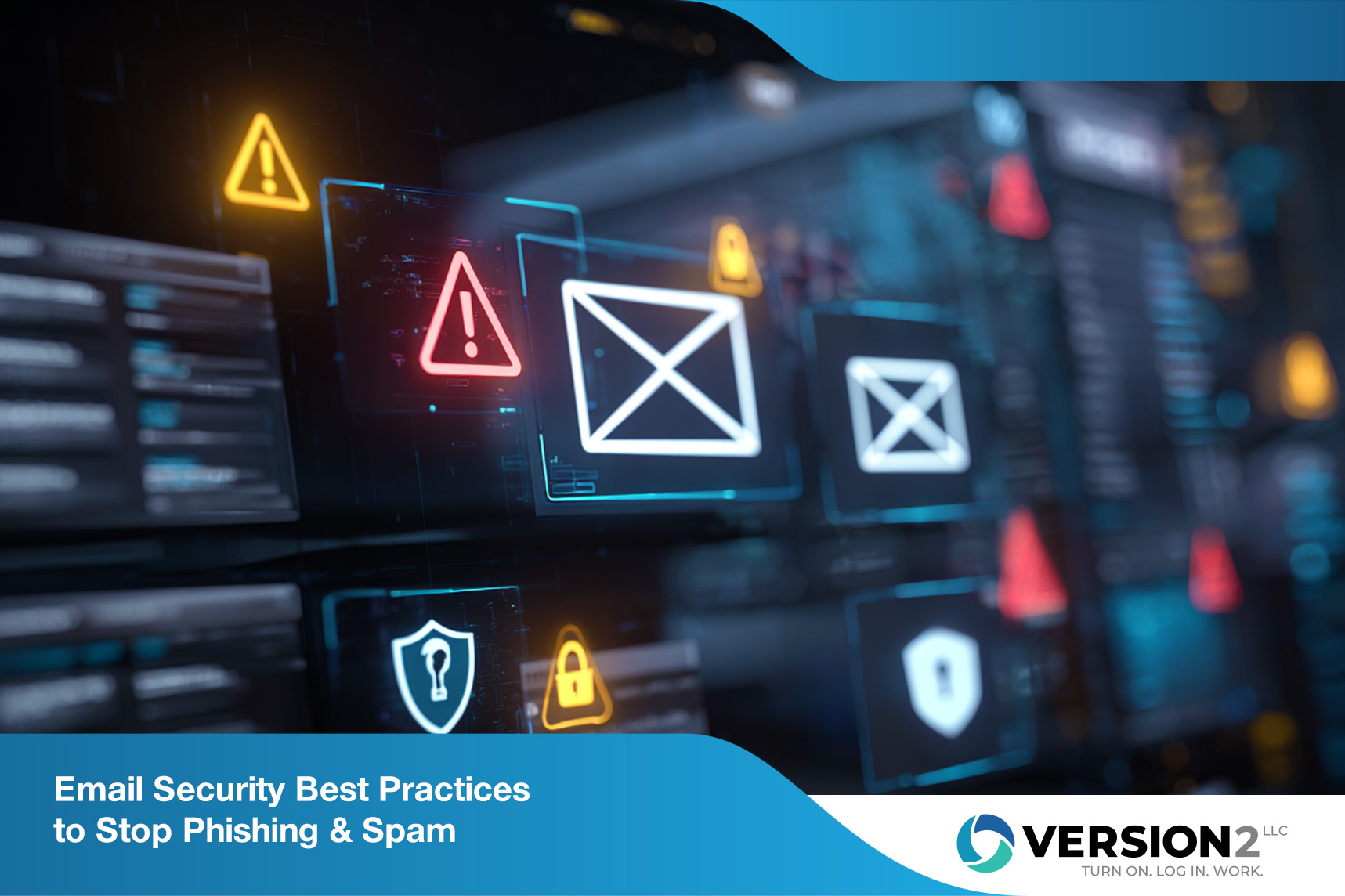
November 27, 2025
Network Firewall Configuration Tips to Secure Your Firewall
Learn how to master network firewall configuration, avoid common mistakes, and secure your systems with proper rules and policies.
July 29, 2025
.jpg)
Imagine waking up to the news that your business has been hit by a data breach—your sensitive information exposed, operations disrupted, and your reputation hanging by a thread. If you're like most business owners, that’s a nightmare scenario you hope never to face. But hope isn’t a strategy.
Here’s the hard truth: cybersecurity threats aren’t just targeting Fortune 500 giants anymore. Small to mid-sized businesses in Illinois—especially in industries handling sensitive data—are increasingly in the crosshairs of cybercriminals. The worst part? Most don’t even realize their vulnerabilities until it’s too late.
You’ve built your business with grit and sleepless nights. But without a proper IT risk assessment, you're gambling everything you've worked for. An IT security risk assessment is more than a checklist—it’s your line of defense against hidden cyber risks, security threats, and those lurking vulnerabilities in your systems that could cripple your operations overnight.
If you’re serious about protecting your business from the unknown, it’s time to take this seriously. In this guide, we'll walk you through why a risk assessment isn’t optional anymore, the types of security risks threatening your livelihood, and how to perform a cybersecurity risk assessment that safeguards what matters most.

A risk assessment is the process of identifying, analyzing, and evaluating the security risks that threaten your business’s technology and information systems. Think of it as a health check, but for your digital environment. Just like you wouldn’t skip a medical exam if you had symptoms, you shouldn’t ignore the vulnerabilities silently weakening your organization’s security posture.
At its core, an IT risk assessment helps you uncover where your critical assets—like customer data, financial records, or proprietary information—are exposed to potential threats. This could include everything from cyberattacks, human errors, outdated software, to even natural disasters that could knock your systems offline.
But it’s not just about identifying risks. A proper security risk assessment goes further by:
Many business owners assume their antivirus or firewall is enough. The reality? Those are just tools—not a complete risk management framework. Without a structured risk assessment process, you’ll always be reactive, fixing problems after they happen instead of preventing them.
A thorough information security risk assessment follows a clear methodology—often guided by standards like NIST SP—to ensure every angle of your security is covered. Whether it's technical risk assessment or examining your security policies, the goal of a risk assessment is to reduce your overall risk exposure by shoring up gaps before they’re exploited.
In other words, a risk assessment aims to shine a light on what’s lurking in the dark so you can take action with confidence.
Let me ask you this—how much would a cybersecurity incident cost your business? Not just in dollars, but in trust, reputation, and time. If you don’t have a clear answer, that’s precisely why an IT risk assessment should be at the top of your priority list.
When you’re steering a business, every decision carries risk. But cyber risks? They’re a different beast. These aren’t just random events. They’re persistent, evolving, and often invisible until it’s too late. Without a solid risk assessment, you’re effectively blind to the vulnerabilities in your systems, leaving you wide open to attacks you can’t even see coming.
A structured security risk assessment provides the clarity you need to:
Remember, the goal isn’t just to tick boxes. It’s to build an information security strategy that aligns with your specific business processes and risk appetite. And it’s not just about the tech—you’re also protecting the human side of your business: your employees, customers, and partners who share sensitive information with you every day.
Without an IT security risk assessment, you won’t just face external cyber threats. Internal risks—like employee mistakes or poor security practices—can be just as damaging.
And here’s the kicker: many industries are subject to strict compliance requirements around data security and information security. Without a formal risk management program, you could face regulatory penalties on top of the operational chaos of a security event.
A cybersecurity risk assessment is your insurance against these risks. It’s your blueprint for smart, proactive decisions that keep your business operational, no matter what security incidents come your way.

If you think your business is too small to attract a hacker’s attention, think again. Cyber attackers love easy targets, and without a proper risk assessment, you might already be one.
Understanding the most common security risks is the first step toward protecting your business. Let’s break them down:
These deceptive emails or messages trick employees into revealing sensitive information, like passwords or financial data. One wrong click, and your entire information system could be compromised.
This is a type of malware that encrypts your files, demanding payment to unlock them. Without the right security controls in place, you could lose access to critical information—or worse, pay a ransom just to resume business.
Skipping updates? That’s like leaving your front door wide open. Regular security patches are essential to fix known vulnerabilities that hackers actively exploit.
Sometimes, the danger comes from within. Disgruntled employees or careless mistakes can lead to a data breach, especially if access to sensitive information isn’t tightly controlled.
If your security policies are outdated—or worse, nonexistent—you’re inviting trouble. Weak guidelines make it easier for security threats to exploit gaps in your security processes.
Simple or reused passwords are a goldmine for attackers. Without strong password policies, you increase your cyber risk significantly.
If you’re not running regular automated vulnerability scanning tools, you’re operating blind. These tools help detect vulnerabilities in your systems before an attacker finds them first.
Vendors and partners often have access to your information systems. If their security practices are weak, their vulnerability and threat landscape becomes yours too.
You don’t need to be a tech expert to understand the importance of a risk assessment, but knowing how to execute one effectively can save your business from disaster. Let me guide you through a step-by-step approach that any business owner can grasp, without the jargon.
Start by taking stock of your critical assets—those parts of your information system that, if compromised, would devastate your business. Think customer databases, financial records, intellectual property, and any sensitive data that you simply cannot afford to lose.
Next, figure out where the danger lies. What potential threats could target your systems? This includes cyberattacks, employee errors, system failures, and even natural disasters.
Simultaneously, pinpoint your vulnerabilities—the weak spots in your hardware, software, and security practices that could be exploited.
This is the heart of the risk assessment process. For each vulnerability, conduct a risk analysis by asking:
This helps you assess risk accurately, allowing you to understand the risk level and the potential fallout for your business.
Not all risks and vulnerabilities are created equal. After your risk analysis, it’s time to prioritize. Which security risks require immediate action? Which ones can be monitored over time? This is where a risk management program truly begins to take shape.
For each priority risk, establish security controls to either eliminate or mitigate the threat. This could be technical measures like firewalls and encryption, or procedural controls like employee training and updated security policies.
Document your findings, the methodology used, the assessment tool applied, and the mitigation plan. This isn’t just for compliance—it’s for your own clarity and continuity.
A thorough risk assessment isn’t a one-and-done deal. As changes occur within your organization, new vulnerabilities can emerge. Make it an ongoing process—reassess regularly, update your security program, and ensure your security team stays informed.

Completing a risk assessment is a massive first step, but the real protection comes from what you do next. Once you’ve identified the security risks, vulnerabilities, and potential cyber threats, it’s time to put robust measures in place to strengthen your defenses. Here’s how you can elevate your cybersecurity posture and keep your business resilient:
Address the identified risks with layered defenses. Think beyond basic antivirus tools—implement firewalls, intrusion detection systems, and encryption protocols. These additional security controls act as barriers that make it harder for attackers to breach your systems.
Use automated vulnerability scanning tools to continuously check for new vulnerabilities in your systems. Pair this with a strict schedule for applying security patches and updates. This minimizes residual risk and closes security gaps before they’re exploited.
Your team is often the weakest link. Update your security policies to include strict access controls, password protocols, and guidelines for handling sensitive data. Train employees regularly to recognize phishing attempts and other security threats.
Align your approach with a recognized risk management framework, like NIST, which offers comprehensive guidelines for reducing cyber risk. The NIST SP framework is particularly effective for building a structured, repeatable risk management program.
Prepare for the inevitable. No system is foolproof, so having a clear response strategy for any security event or data breach ensures you can act quickly, contain the damage, and recover effectively.
Risk assessments also reveal that threats evolve. A static defense won’t cut it. Continuously monitor your systems and security processes, and re-evaluate your organization’s security posture as new risks surface.
If you have an information security team, empower them with the tools and authority needed to implement these measures. If not, partner with experts who can guide your technical risk assessment and provide insights tailored to your organization’s needs.
Let’s be honest—ignoring your company’s risk assessment needs is like driving without insurance. It’s not a question of if a security event will happen, but when. And when it does, will you be ready—or will you be scrambling?
By conducting an IT security risk assessment, you’re doing more than checking for weak spots. You’re actively protecting your critical information, securing your operations, and giving your security team the tools to act before threats spiral out of control. The risk assessment is to reduce the chances of a breach, preserve your reputation, and ensure your business stays operational, no matter what.
The good news? You don’t have to navigate this alone. If you’re in Illinois and ready to strengthen your organization’s security, there’s help. Our team at Version2 specializes in guiding businesses like yours through every step of the cybersecurity risk assessment process—from the first scan to a full mitigation plan.
Let’s close your security gaps, shore up your defenses, and protect your future. Before the next threat strikes, take the steps to safeguard your success.
The risk assessment process is the structured approach businesses use to identify, evaluate, and prioritize risks that could harm their systems, data, and operations. By following a systematic methodology, companies can proactively spot threats to their information assets and apply the right security measures to safeguard them. This process is essential because it protects your organizational resilience and ensures you’re not caught off guard by unseen dangers.
A security risk assessment helps businesses mitigate threats by first identifying categories of risk, including cyber risks, operational risks, and technical risks. Through thorough impact analysis, businesses understand the potential damage of each threat, allowing them to develop specific strategies and controls to reduce their risk posture and prevent incidents from escalating.
A cybersecurity risk assessment is a focused evaluation of your digital infrastructure to identify cyber threats and vulnerabilities that could lead to breaches. It’s not a one-time task but an ongoing process that should be revisited regularly, especially after major tech updates, system changes, or organizational shifts. This consistent vigilance helps maintain strong system security and keeps your defenses current.
To perform a cybersecurity risk assessment, you need to:
Many businesses align with popular frameworks like NIST, which guide the cybersecurity risk assessment process using tested standards and practices.
A technical risk assessment zooms in on the technology itself—your networks, servers, software, and hardware—to pinpoint vulnerabilities in your infrastructure. While a broader risk assessment process considers people, processes, and policy, the technical risk assessment is a deep dive into your tech stack to ensure every layer of system security is fortified.
A defined methodology ensures that your cyber risk assessment is consistent, comprehensive, and repeatable. It provides structure to the information gathered, ensuring that nothing critical is overlooked. More importantly, it gives the security team a framework for making informed decisions about protecting the sensitive data that keeps your business running.

November 27, 2025
Learn how to master network firewall configuration, avoid common mistakes, and secure your systems with proper rules and policies.

November 26, 2025
Discover email security best practices to protect your business from phishing, spam, and other email threats. Learn practical steps and tools that work.

November 24, 2025
Learn how business password management helps protect your company from breaches, streamline access, and secure sensitive data with the right tools and policies.